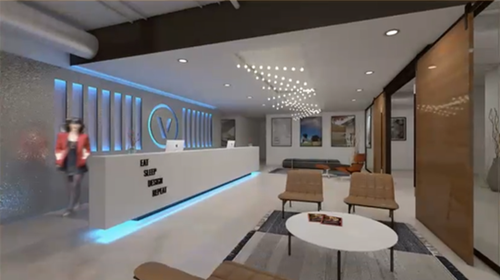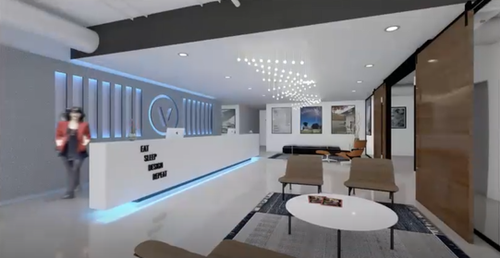Render styles
A render style saves the settings for the selected render mode, the render mode options, the lighting options, the camera effects, and a Renderworks background into a single resource that can be applied to design layers or to viewports. By collecting these varied settings into a single resource that applies the settings simultaneously, render styles give you the flexibility to change quickly among styles and render modes while working interactively in a model. You can design in a responsive render mode such as Shaded, and then quickly change to a render style or a Renderworks render mode to confirm that lighting, textures, and other details will display as desired in a final rendering. You can efficiently try different render styles to see how they affect the rendering.
Render styles are resources that are saved with the file and displayed in the Resource Manager. They can be applied to design layers from the View bar and to a viewport when creating the viewport or viewport style, or later from the Object Info palette. Render styles can be shared, just like any resource. Several default render styles are provided to quickly obtain a variety of looks, with no parameter adjustment or rendering knowledge required. You can also create custom render styles.

Left to right: Realistic Exterior Night Final, Realistic White Model, and Artistic Taper Thick Black
Render styles can be created using an Artistic Renderworks type that provides a variety of sketch-like and color-blocked options, Shaded rendering, Showcase rendering (Spotlight required) that is based on shaded options with additional settings needed for Showcase, or one of two render types, Realistic or Realistic RS, that can achieve photorealistic results.
When creating a render style, you may find it easier to save a copy of an existing render style that is similar to the desired appearance, and edit it, rather than creating a completely original style.
When creating a render style, use the by style and by instance settings to provide the needed balance between control and flexibility; set some parameters to be locked by the style and others that can be changed for each rendering instance that uses the render style.
Render styles can incorporate Renderworks backgrounds, with all their settings, into the style definition. Styles based on the Realistic, Shaded, and Showcase options also allow you to specify additional backgrounds to use for environment lighting and environment reflections. Background environment reflections can have a huge impact on scenes with reflective surfaces, such as windows and plastics, preventing the scene from looking flat.
Most render styles can apply camera effects to the rendering, with or without an active Renderworks camera.
When a render style is the selected Background Render mode for a viewport or viewport style, the render style dictates the background render settings and lighting options for the viewport.
Creating a genuinely photorealistic rendering can take a tremendous amount of time, as you try to balance the lighting, textures and reflections required. For a Realistic type render style, you can save time by creating a more conceptual style. This can be achieved by using subtle artistic edges to ease away from a completely photorealistic look, and stop the viewer's brain from trying to solve the puzzle of what's not quite right. This small step away from complete photorealism can also present your design as more open to adjustment, should the client not like some of the finishes presented.
Alternatively, you can set the viewport's Foreground Render to Sketch, to create a similar effect that is not saved as part of the render style.
Choosing a photorealistic render type
Render styles created using the Realistic and Realistic RS types have different strengths and benefits, to meet a variety of presentation needs. Both create photorealistic renderings, by interpreting lighting and textures differently. The two types offer various rendering options, and each supports different features. For the best results, match the rendering type and settings to the scene and visual effects.
Realistic
The Realistic rendering type, which is powered by the Cineware® Engine by Maxon, is based on the Custom Renderworks render mode. It produces a high-quality rendering. It processes some textures, including grass, shadow catcher, cloth, some metallics, and bump displacement and parallax, that are not currently supported in Realistic RS. Realistic also uses some lighting types and effects, including area and line lights, caustics, and separate backgrounds for reflections, that are not currently used in the Realistic RS rendering type. Use Realistic rendering for these kinds of effects.
Renderings that do not rely heavily on ray tracing to create lighting effects are often processed faster in Realistic.
Realistic RS
Realistic RS excels at the processing of large models with lots of geometry and complex rendering effects, including blurred reflections, indirect lighting, glow textures, camera effects, and anti-aliasing. Realistic RS is available only within a render style, not as a stand-alone render mode. Render styles with Realistic RS interactive preview rendering (IPR) capability enabled provide a progressive, interactive preview as the file is edited on a design layer in a 3D view.
If the hardware supports it, Realistic RS rendering technology uses the computer's GPU to generate high-end production renderings of large or complicated 3D models more quickly than renderings processed on the CPU. See vectorworks.net/sysreq for Realistic RS's system requirements for processing on the CPU or GPU. Computers that do not support Realistic RS default to a Realistic type instead. If you have a subscription or access to Vectorworks Service Select benefits, you can process Realistic RS style renderings on Vectorworks Cloud Services.


The Realistic render type (top) and Realistic RS render type (bottom) both provide high-quality renderings of this corporate reception area, but they interpret light, reflections, and textures differently
